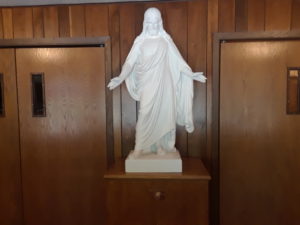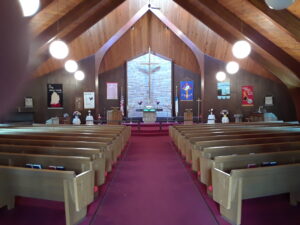The word “epiphany” means “to show” or “to manifest.” Therefore, during the church season of Epiphany, Jesus shows Himself to us, or manifests Himself to us. What does Jesus show us? The church season of Epiphany begins with Jesus being visited by the Magi and ends with Jesus being transfigured. In the story of “the Visit of the Magi” (see Matthew 2:1-12), the Magi represent the world. For that reason, in the story of “the Visit of the Magi,” Jesus shows Himself to the world, not only to His own people: the Jews. In the story of “the Visit of the Magi,” Jesus shows that He doesn’t come just for His own people, the Jews, but for the whole world. In the story of Jesus being transfigured (“the Transfiguration”: see Matthew 17:1-9, Mark 9:2-9 and Luke 9:28-36), Jesus shows Himself to be God. He is transfigured between Moses and Elijah, showing that He fulfills the Law of Moses and prophecies of Elijah. At the end of the story, however, Jesus tells His disciples not to tell anyone what they have seen until He is risen from the dead (Matthew 17:9 and Mark 9:9). Consequently, in the story of Jesus being transfigured, He shows that He must suffer, die and be resurrected from the dead.
Although the showing of Jesus to us is emphasized during the church season of Epiphany, he shows Himself to us throughout the church year. The seasons of the church year are: (1) Advent; (2) Christmas; (3) Epiphany; (4) Lent; (5) Easter; and (6) Pentecost. Beginning with Advent and ending with Pentecost, Jesus shows Himself to us as someone or something.
The word “advent” means “to come.” The church season of Advent begins with “the Triumphal Entry” of Jesus (see Matthew 21:1-11, Mark 11:1-10, Luke 19:28-40 and John 12:12-15). The traditional gospel reading for Palm Sunday, “the Triumphal Entry” tells the story of Jesus riding into Jerusalem on a little baby donkey during the festival of the Passover. So, in “the Triumphal Entry,” Jesus shows Himself to be the true Passover lamb when He rides into Jerusalem on the day when the Passover lamb was selected, paraded through the streets and presented to the people. As a result, Jesus also shows that He “comes” (from “advent”: “to come”) to be a sacrifice.
Whereas the church season of Advent shows that Jesus is coming, the church season of Christmas shows that Jesus has come. It begins with the traditional Christmas story of Jesus’ birth and ends with Mary and Joseph finding “the Boy Jesus at the Temple” in Jerusalem. In the traditional birth narrative of Jesus (“the Birth of Jesus” and “the Shepherds and the Angels”: see Luke 2:1-20 and below), the shepherds represent the world. As a consequence, what the angels say to the shepherds, they are saying to the world. Thus, in the traditional birth narrative of Jesus, He is showing that He has come for the world: “I bring you good news of great joy that will be for all the people. Today in the town of David a Savior has been born to you; he is Christ the Lord. This will be a sign to you: you will find a baby wrapped in cloths and lying in a manger” (verses 10-12: bold print added). In the story of “the Boy Jesus at the Temple” (see Luke 2:41-52), Jesus asks Mary and Joseph, “Didn’t you know I had to be in my Father’s house” (verse 49)? The temple in Jerusalem, Jesus’ “Father’s House”, is a place of forgiveness. The Jewish people of the New Testament go to the temple to receive forgiveness by saying the correct words and making the correct sacrifices. Accordingly, the story of “the Boy Jesus at the Temple” shows Him in the place where sacrifices are made. The story makes the connection between Jesus and sacrifice: He has come to make a sacrifice.
The remainder of the church year [(4) Lent; (5) Easter; and (6) Pentecost] will be discussed in What Is Jesus Showing Us During The Church Year? – Part Two.
8 And there were shepherds living out in the fields nearby, keeping watch over their flocks at night. 9 An angel of the Lord appeared to them, and the glory of the Lord shone around them, and they were terrified. 10 But the angel said to them, “Do not be afraid. I bring you good news that will cause great joy for all the people. 11 Today in the town of David a Savior has been born to you; he is the Messiah, the Lord. 12 This will be a sign to you: You will find a baby wrapped in cloths and lying in a manger.”
– Luke 2:8-12

